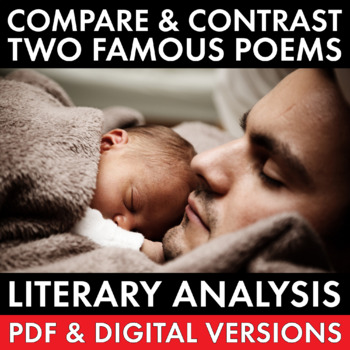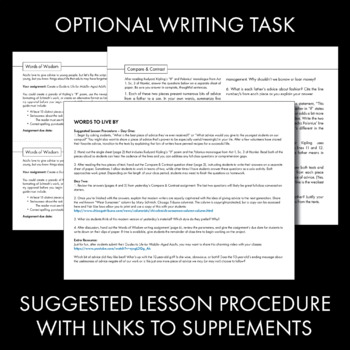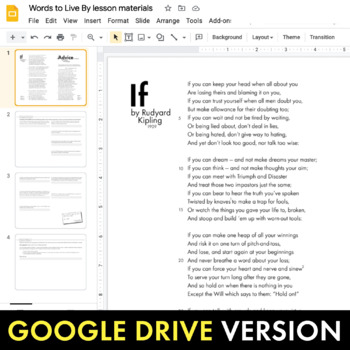Compare & Contrast Poetry, Hamlet & Rudyard Kipling's "If" – PDF & Google Drive
- PDF
- Google Apps™

What educators are saying
Description
Help students analyze how a similar theme is developed in three different mediums by using Rudyard Kipling’s timeless poem “If,” Polonius’ advice to his son in a brief monologue from William Shakespeare’s Hamlet, and a newspaper columnist’s Guide to Life that went viral in the late 1990s. (Remember that whole “Wear Sunscreen” thing?)
This fun, attention-grabbing lesson was built to entertain and challenge high school students in grades 9 through 12, though advanced middle school students will also enjoy the materials.
The 6-page download includes (PDF + Google Drive version of student handouts):
• Detailed, step-by-step lesson procedure suggestions
• One-page attractively designed presentation of Rudyard Kipling’s “If” poem and Polonius’ “To thine own self be true” monologue to his son Laertes from Act 1, Scene 3 of Shakespeare’s Hamlet (includes wide margins to make annotation easier)
• Critical-thinking question handout that requires students to dig back into both texts and their own minds to find the answers
• Detailed answer key, designed to make grading easy and help you guide class discussion
• Optional creative writing activity where students flip the script and build their own Guide to Life, giving advice to middle-aged adults about how to live a full and satisfying life
• Links to modern text and video content
Due to the reflective nature of these pieces, this lesson works especially well as an end-of-term activity.
Want additional lessons like this? Click HERE for more high-interest informational text lessons.
NOTE: This item is also included in my English 9-10 full-year curriculum. If you already own the full-year download, please do not purchase this item here individually. If you’d like to receive this item plus everything else needed to teach 180 days of English 9 or English 10 at a deeply discounted price, click here to learn more about the full-year curriculum download.
Thanks for stopping by!
Cover image credit: Pixabay, Public domain





